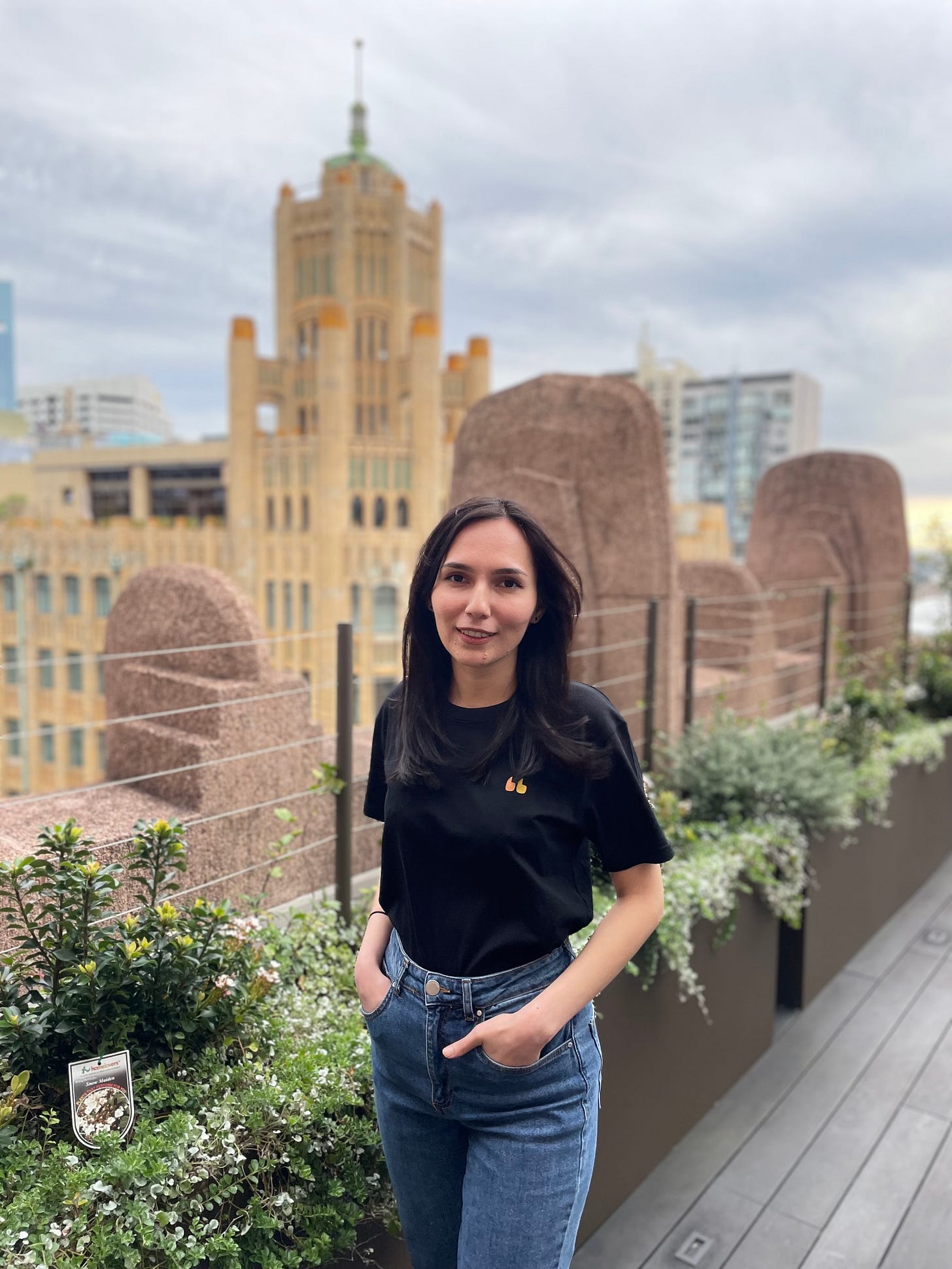🌞 From Marketing to Product Management
Steppen Product Manager, Ryan Van, breaks down his career and explains the differences between Marketing and Product.
Ello ello Earlyworkers!
Bringing the heat this week is Earlywork #78, a weekly cheeky newsletter sharing insights into future-focused careers for the next generation of founders & operators.
If you’re not yet in the Earlywork community, come grow your career alongside thousands of other young people interested in tech, startups & social impact:
Farewell & Welcome 🌟
Been a busy week at EarlyworkHQ farewelling two legends and welcoming in a superstar this week!
Varun & Jarrad have been with us for the last 3 months and we couldn't be prouder of what they've achieved during their time at Earlywork 🙌
Varun is heading over on exchange to Canada while Jarrad is joining OwnHome and have no doubt they will both be future leaders in the ecosystem 🔥
Extremely stoked to also have Elaha joining us as our first full-time hire as Community & Ops Lead 💫
Have watched from the sidelines in awe as Elaha has crafted her superpower from an OG community keen bean to be in the top 1% of community builders locally and can't wait to see what we can do together 🔮
The Buzz 🐝
Here are the five biggest news stories across the tech & startup scene you need to know this week:
What bear market!? Adam Neumann is back with $350m in dry powder to his name for his new startup Flow 👀
Give that PM a raise! Snapchat+ doing $48m in ARR one month after launch 🚀
Sack that PM! COVIDSafe app abandoned after $21m spent 👎
Aussie cancer startup teams up with US telehealth giant in $9b deal 🤝
Still in denial. Starburst announced their departure from Australia 😭
💡Weekly Cheeky Tip
Are you currently a marketer but looking to work on the core product more directly?
Product management might be just what you are looking for 👀
At Earlywork, we’ve covered a lot about both the individual marketing and product management disciplines.
But how do the two stack up?
We spoke to Ryan Van (Product Lead @ Steppen, Founder @ The Marketing Insider) breaking down his career, key learnings and advice in moving from marketing 👉 product management:
A few months ago I made the “official” transition into product management. It was a carefully plotted plan that was years in the making.
OKRs were set, thousands of courses were consumed and many more product managers were networked with.
Finally, a once unattainable feat was within reach…
Just kidding, my transition was more of a coincidence than a masterminded plan 😅
I’ve actually always worked in tech and wanted to best equip myself with the skills to be a founder or early-stage investor.
So whilst marketing provided me with skills applied later in the product life cycle, I felt a gap in my product discovery and delivery acumen.
As such, becoming a product manager in a startup felt like the space to sharpen these abilities in a hands-on manner.
With that in mind, I implore any marketers interested in transitioning to ask themselves; why do I actually want to become a product manager?
Trust me, the prestige of saying you’re a product manager won’t get you through the feelings of imposter syndrome when talking to developers, the confusion of Jira (sorry Dan 😬) or the overwhelming feeling of setting and achieving a product vision.
You’re more of a Product Manager than you think 🤔
Let’s talk about 2 transferable skills between marketers and product managers in startups:
Bringing certainty to areas of uncertainty
An inherently experimental mindset
Bringing certainty to areas of uncertainty
Similarities lie in the problem-solving mindset
Apart from operating in different areas, product managers and marketers exist to solve business problems - rather than just maintaining an existing system.
After transitioning, I’ve found success applying this 4 step problem-solving process in both marketing & product roles:
Understand the root cause of a problem
Setting a north star metric to determine success
Brainstorming solutions
Effectively communicating which solution you choose and why
An inherently experimental mindset
Planning and executing rapid tests to de-risk the downside of a significant decision.
As a marketer, I was taught to run experiments before committing to a larger decision. For instance, I would run a series of A/B tests on email click-through rates to verify if new copy and design variations outperformed the old ones, before implementing a new email onboarding sequence.
Today, I still apply the same concepts as a product manager but in a different fashion. Showcasing lo-fi app designs to current users and iterating on the UX and UI before committing anything to our designer and developers.
Time to take action 💪
Here are 2 actionable points that I followed (very loosely) to transition to product management:
Making my own experience
Identifying great product roles in startups
Making my own experience
Building a side project did 2 crucial things for my career in product management
solidified my knowledge from the abundance of theoretical content
positioned me as an exemplary candidate
When building The Marketing Insider, I first identified a personal problem - that it was difficult to connect with other professional marketers at scale.
Then I applied product discovery learnings from a Product Go course to validate my problem and spoke to 10 uni students, settling on a persona and ideating potential solutions - which ended up being a website publication.
Between December 2021 and June 2022, I scaled The Marketing Insider blog from 0 to 2000+ monthly visitors.
Then showcasing my work through Linkedin and a personal website.
Questions to ask yourself:
What’s a problem that annoys me?
What resources can I use to learn about building a product from 0 to product market fit?
How can I showcase this work to prospective employers?
Identifying great product roles in startups
Get involved in the local ecosystem and have certain criteria in mind before applying for a role.
The same product manager role at Atlassian and Steppen have entirelyyyy different hours, mentorship opportunities and scope of responsibilities.
Before applying for roles, I looked inward and found that I learn best when given (1) autonomy and (2) a high level of responsibility.
Hence, I decided to go down the startup product manager route. However, I realised that startup product manager roles had sporadic availability.
As such, to stay across opportunities I got involved in the Australian startup ecosystem via;
Joining and participating in the Earlywork community
Subscribing to newsletters from Blackbird, Startmate, Smart Company and Startup Daily - then following featured companies on Linkedin that operated in a problem space of interest (I found Steppen off a capital raise announcement article!)
Three lessons from four months in product management 💡
1 - Peers > frameworks
I was obsessed with product management frameworks when I first transitioned over. Affinity maps, user flow mapping, the double diamond, RICE prioritisation…
Over time, however, I’ve realised that there are no identical product management roles, and these frameworks apply a cookie-cutter approach to problem-solving that’s more of an art than a science.
Hence, I’ve found more value in sharing product ideas and receiving tailored advice from (1) other early career product managers (h/t Earlywork) and (2) product managers who have solved a problem that I’m experiencing before (h/t ADPList).
2 - Don’t build features without a constant pulse on who’s using your product
As a marketer, I loved the autonomy and initiative I was given to pursue an idea.
I had trained a muscle for ideating, implementing and analysing a test or campaign by myself. As a product manager, however, I’ve learned that my ideas and decisions impact more than just me.
The best way to minimise the downside of a specific decision is to always talk to the people using the product.
3 - Metrics are for decision making, not optimisation
Metrics should be seen as a guiding north star, however, the path that’s taken to get there is flexible.
Being comfortable with not having a sequence of concrete solutions to achieve a goal is a muscle I’m still building.
If you’re new here, welcome! Subscribe now to keep a pulse on our latest stories:
Vibed with this piece? 🍵 Shout us a cheeky herbal tea
Keen to learn more about what we do? Join the Earlyjourney and hit us up on:
🧡 Earlywork Community
🤝 LinkedIn
🐦 Twitter
📸 Instagram
🎶 TikTok
💌 Email
Ciao for now,
Team Earlywork (Dan, Jono, Marina, Elaha)
If you’ve got a mate who would find this helpful, spread the love and share it:






